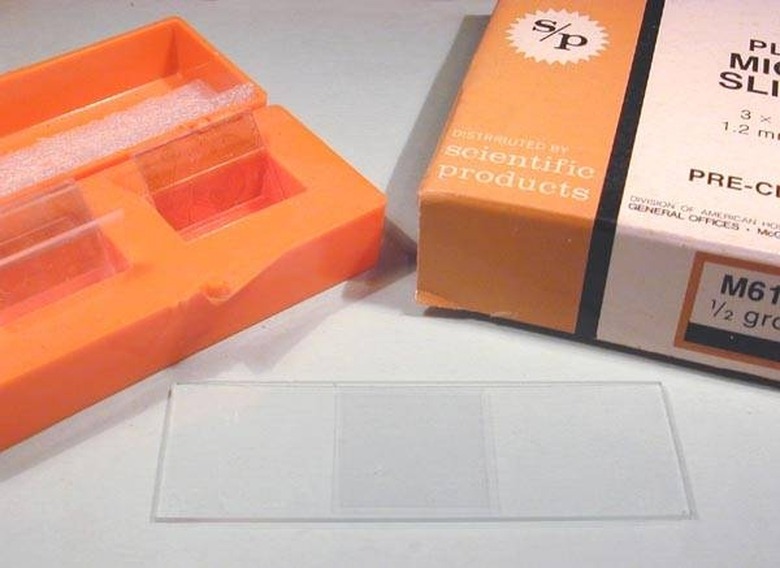What Is A Glass Slide In Biology?
A glass slide is a thin, flat, rectangular piece of glass that is used as a platform for microscopic specimen observation. A typical glass slide usually measures 25 mm wide by 75 mm, or 1 inch by 3 inches long, and is designed to fit under the stage clips on a microscope stage. Glass is the preferred transparent material, as it allows light to freely pass through it with a very low refractive index — the measure that light bends as it passes through a substance.
Viewing Under Magnification
Viewing Under Magnification
Once a glass slide is placed under the microscope, the specimen can be viewed through the eyepiece. The eyepiece lens usually magnifies the image 10 times its original size. This magnification is then further multiplied by the chosen power of the microscope's objective lenses — 4, 10, 40 or 100 times magnification. In combination on a standard light microscope, the glass slide's specimen may be viewed at 40X, 100X, 400X or 1000X magnification.
Prepared Slides
Prepared Slides
Prepared slides are glass slides that already have the specimen preserved and affixed to the slide. Very thin sections of the material — tissues or microorganisms — undergo the preservation process, which begins by killing the specimen. It is then fixed with a preservative that stunts any further deterioration of the specimen. Next, it is soaked in paraffin, or a similar material, and allowed to harden. The hardened material is then sliced into very thin sections that are then mounted to the center of the glass slide. This is then covered with a slide mounting fluid, such as permount, and covered with a thin cover slip.
Wet Mount Slides
Wet Mount Slides
Glass slides are also used to prepare specimens for microscopic visualization on the spot. With wet mount preparations, the specimen — microorganisms, plant or animal tissues — is placed in a drop of water or saline at the slide's center. A cover slip is then carefully placed on top by placing one edge on the slide and slowly lowering the other side over the specimen. Wet mounts, or fresh mounts, are a good way to examine tissue that has not been preserved, or that may still be living.
Wet Mount Slides with Staining
Wet Mount Slides with Staining
Stains, or dyeing chemicals, can be applied to fresh tissue. The purpose is to increase the contrast so that different parts of the material are clearly defined. Some stains yield different colors, based on the characteristics of the specimen, such as the Gram stain, which divides bacteria into Gram-positive and Gram-negative categories.
Glass Slide Preparations
Glass Slide Preparations
Some common glass slide preparations in biology are the onion or allium root tip, amoeba, bacteria — coccus or round, spiral and rod shaped, diatoms, frog blood and cells, human blood, skin and hair, and flatworms or planaria. These and other specimens are available as prepared slides from science lab companies, while many scientists, doctors, laboratory specialists and educators prepare their own slides, both wet mount and prepared glass slides.
References
Cite This Article
MLA
Manal, Naima. "What Is A Glass Slide In Biology?" sciencing.com, https://www.sciencing.com/glass-slide-biology-5139884/. 24 April 2017.
APA
Manal, Naima. (2017, April 24). What Is A Glass Slide In Biology?. sciencing.com. Retrieved from https://www.sciencing.com/glass-slide-biology-5139884/
Chicago
Manal, Naima. What Is A Glass Slide In Biology? last modified March 24, 2022. https://www.sciencing.com/glass-slide-biology-5139884/
